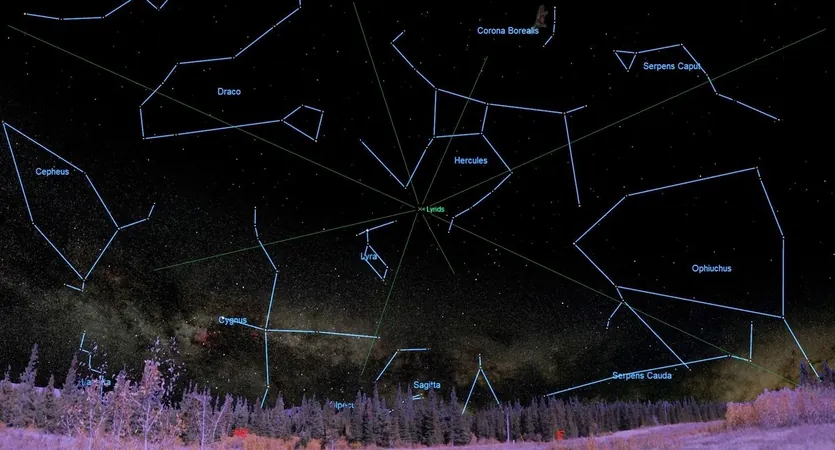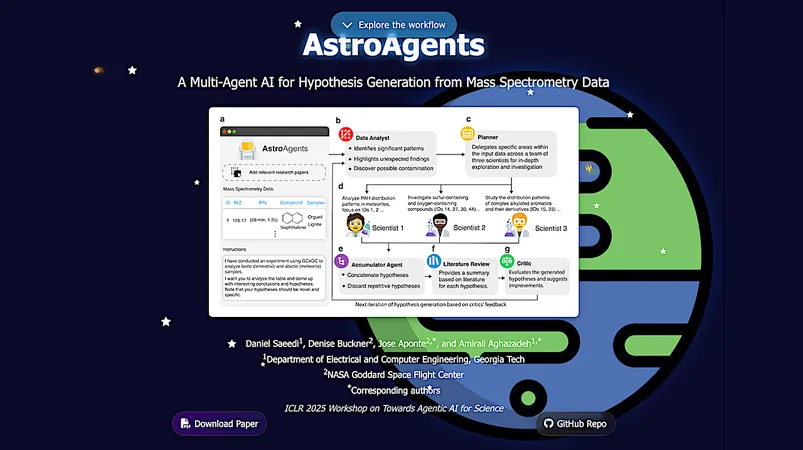
The Lyrid Meteor Shower 2025: Will We Be Graced with a Dazzling Outburst?
2025-04-06
Author: Ming
As we approach April, stargazers are preparing for an exciting astronomical event—the Lyrid meteor shower. Known for its historical significance and sporadic brilliance, the Lyrids are one of the oldest documented meteor showers and are a beloved highlight for night sky enthusiasts.
After a quiet spell since the Quadrantids in January, the skies will soon come alive with the radiant dance of the Lyrids. Meteor expert Peter Jenniskens refers to this annual event as "the proverbial swallow of spring” in the northern hemisphere, signaling the end of winter's stark meteor counts.
This year's Lyrid meteor shower is anticipated to peak on the morning of April 22, when the waning crescent moon will lend minimal interference, only illuminating 36 percent of the night sky and not rising until approximately 3:30 a.m. local time.
Uncertain Yet Exciting Peak
Historically, the Lyrids have produced unpredictably spectacular bursts of activity. The optimal viewing time is expected around 1330 UTC (9:30 a.m. ET), according to data from past observations. However, fluctuating peak times in recent years suggest that the most active period could occur anywhere between 10:30 UTC and as late as 18:00 UTC—favoring those in the Mountain and Pacific time zones for a potentially ideal viewing experience before dawn.
Stargazers should position themselves beneath the bright star Vega, which is located in the constellation Lyra. While the Lyrids are not the most prolific shower, averaging about one meteor every three to five minutes at peak, their vivid brightness makes them a thrilling sight.
Expect the Unexpected
The Lyrids have a reputation for delivering occasional surprises. Historical records reveal events where meteor showers dazzled observers unexpectedly, including the stunning display witnessed in Richmond, Virginia, in 1803. That occasion, where meteors rained down like fireworks, is just one of many documented moments that highlight the shower’s erratic nature and the joy of unpredictability in astronomy.
Modern astronomers established that the Lyrid meteors originate from the debris of Comet Thatcher, which completes its orbit every 415 years. While the last appearance of this comet was in 1861, its remnants continue to light up our skies, offering a connection to celestial history.
In addition to the Lyrids, the later part of April may also present the chance of spotting a brilliant fireball meteor, showing signs of possibly dropping meteorites. Records from the 1960s indicated that meteors from this period exhibited similar trajectories, suggesting a potential meteor shower occurrence in late April.
Best Viewing Practices and Tips
To catch the Lyrid meteors, you should start your vigil from midnight to early dawn when Vega is prominent in the eastern sky. Due to the unpredictable intensity of the Lyrids, it's beneficial to keep an eye on the sky a night or two before and after the peak, as many meteors might still be visible during this period.
For the best experience, set your alarms for the early hours of April 22 and prepare to look up. You never know when the sky might surprise you—these celestial shows, filled with cosmic fireworks, could be just a gaze away.
So gear up, grab your blankets, and get ready to enjoy a magical night under the stars—April’s celestial show is poised to captivate!



 Brasil (PT)
Brasil (PT)
 Canada (EN)
Canada (EN)
 Chile (ES)
Chile (ES)
 Česko (CS)
Česko (CS)
 대한민국 (KO)
대한민국 (KO)
 España (ES)
España (ES)
 France (FR)
France (FR)
 Hong Kong (EN)
Hong Kong (EN)
 Italia (IT)
Italia (IT)
 日本 (JA)
日本 (JA)
 Magyarország (HU)
Magyarország (HU)
 Norge (NO)
Norge (NO)
 Polska (PL)
Polska (PL)
 Schweiz (DE)
Schweiz (DE)
 Singapore (EN)
Singapore (EN)
 Sverige (SV)
Sverige (SV)
 Suomi (FI)
Suomi (FI)
 Türkiye (TR)
Türkiye (TR)
 الإمارات العربية المتحدة (AR)
الإمارات العربية المتحدة (AR)